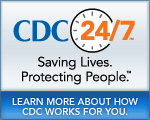We Can Make the Next Generation Tobacco-Free
 2012 Surgeon General's report details important new information about tobacco use among youth and young adults, the causes, and the solutions. Learn how we can work together to end the tobacco epidemic.
2012 Surgeon General's report details important new information about tobacco use among youth and young adults, the causes, and the solutions. Learn how we can work together to end the tobacco epidemic.
Surgeon General's reports (SGRs) on tobacco are among the most credible and respected reviews of current data in all of science. Dr. Regina M. Benjamin, U.S. Surgeon General, has just released Preventing Tobacco Use Among Youth and Young Adults: A Report of the Surgeon General, which is the 31st SGR on tobacco produced by CDC since 1964.
This latest report details important new facts about the epidemic of tobacco use among youth ages 12 through 17 and young adults ages 18 through 25, including the epidemiology, causes, and health effects of this tobacco use and interventions proven to prevent it.
Tobacco Use Among Young People
 We've made progress in reducing tobacco use among youth; however, far too many young people are still using tobacco. Today, more than 600,000 middle school students and 3 million high school students smoke cigarettes. Rates of decline for cigarette smoking have slowed in the last decade, and rates of decline for smokeless tobacco use have stalled completely. In addition:
We've made progress in reducing tobacco use among youth; however, far too many young people are still using tobacco. Today, more than 600,000 middle school students and 3 million high school students smoke cigarettes. Rates of decline for cigarette smoking have slowed in the last decade, and rates of decline for smokeless tobacco use have stalled completely. In addition:
- Every day, more than 1,200 people in this country die due to smoking. For each of those deaths, at least two youth or young adults become regular smokers each day. Almost 90% of those replacement smokers smoke their first cigarette by age 18.
- Rates of smokeless tobacco use are no longer declining and appear to be increasing among some groups.
- Cigars, especially cigarette-sized cigars, are popular with youth. One out of five male high school students smokes cigars, and cigar use appears to be increasing among other groups.
- Use of multiple tobacco products, including cigarettes, cigars, and smokeless tobacco, is common among young people.
- Prevention efforts must focus on young adults ages 18 through 25. Almost no one starts smoking after age 25. Nearly 9 out of 10 smokers started smoking by age 18, and 99% started by age 26. Progression from occasional to daily smoking almost always occurs by age 26.
Immediate and Long-Term Damage
Tobacco use by youth and young adults causes both immediate and long-term damage. One of the most serious health effects is nicotine addiction, which prolongs tobacco use and can lead to severe health consequences. The younger that youth are when they start using tobacco, the more likely they'll be addicted. Other stark facts include the following:
- Early cardiovascular damage is seen in most young smokers; those most sensitive die very young.
- Smoking reduces lung function and retards lung growth. Teens who smoke are not only short of breath today—they may end up as adults whose lungs will never grow to full capacity. Such damage is permanent and increases the risk for chronic obstructive pulmonary disease.
- Youth are sensitive to nicotine and can feel dependent earlier than adults. Because of nicotine addiction, about three out of four teen smokers end up smoking into adulthood, even if they intend to quit after a few years.
- Among youth who persist in smoking, a third will die prematurely from smoking.
Social and Environmental Influences
Youth are vulnerable to social and environmental influences to use tobacco; messages and images that make tobacco use appealing to them are everywhere. In addition:
 Young people want to fit in with their peers. Images in tobacco marketing make tobacco use look appealing to this age group.
Young people want to fit in with their peers. Images in tobacco marketing make tobacco use look appealing to this age group.- Youth and young adults see smoking in their social circles, movies they watch, video games they play, Web sites they visit, and many communities where they live. Smoking is often portrayed as a social norm, and young people exposed to these images are more likely to smoke.
- Youth identify with peers they see as social leaders and may imitate their behavior. Those youth whose friends or siblings smoke are more likely to smoke.
- Youth who are exposed to images of smoking in movies are more likely to smoke. Those who get the most exposure to onscreen smoking are about twice as likely to begin smoking as those who get the least exposure. Images of smoking in movies have declined over the past decade; however, in 2010, nearly a third of top-grossing movies produced for children—those with ratings of G, PG, or PG-13—contained images of smoking.
Tobacco Industry Activities
Tobacco companies spend more than $1 million an hour in this country alone to market their products. This report concludes that tobacco product advertising and promotions still entice far too many young people to start using tobacco.
 The tobacco industry has stated that its marketing only promotes brand choices among adult smokers. Regardless of intent, this marketing encourages underage youth to smoke. Nearly 9 out of 10 smokers start smoking by age 18, and more than 80% of underage smokers choose brands from among the top three most heavily advertised.
The tobacco industry has stated that its marketing only promotes brand choices among adult smokers. Regardless of intent, this marketing encourages underage youth to smoke. Nearly 9 out of 10 smokers start smoking by age 18, and more than 80% of underage smokers choose brands from among the top three most heavily advertised.- The more young people are exposed to cigarette advertising and promotional activities, the more likely they are to smoke.
- The report finds that extensive use of price-reducing promotions has led to higher rates of tobacco use among young people than would have occurred in the absence of these promotions.
- Many tobacco products on the market appeal to youth. Some cigarette-sized cigars contain candy and fruit flavoring, such as strawberry and grape.
- Many of the newest smokeless tobacco products do not require users to spit, and others dissolve like mints. These products include snus—a spitless dry snuff packaged in a small teabag-like sachet—and dissolvable strips and lozenges. Young people may find these products appealing in part because they can be used without detection at school or other places where smoking is banned. However, these products cause and sustain nicotine addiction, and many youth who use them also smoke cigarettes.
- Using advertising and promotional activities, packaging, and product design, the tobacco industry encourages the myth that smoking makes you thin. This message is especially appealing to young girls. It is not true—teen smokers are not thinner than nonsmokers.
The Value of Multicomponent Programs
Comprehensive, sustained, multicomponent programs can cut youth tobacco use in half in 6 years. To that end:
- Prevention is critical. Successful multicomponent programs prevent young people from starting to use tobacco in the first place and more than pay for themselves in lives and health care dollars saved.
- Strategies that comprise successful comprehensive tobacco control programs include mass media campaigns, higher tobacco prices, smoke-free laws and policies, evidence-based school programs, and sustained community-wide efforts.
- Comprehensive tobacco control programs are most effective when funding for them is sustained at levels recommended by CDC.
Three Key SGR Documents
Please refer to the following materials to obtain more information on preventing tobacco use among youth and young adults.
- Full Report
Preventing Tobacco Use Among Youth and Young Adults: A Report of the Surgeon General is a 900-page document that contains the latest science on the health consequences of tobacco use by young people; the epidemiology of tobacco use among youth and young adults; the social, environmental, cognitive, and genetic influences on the use of tobacco by young people; tobacco industry influences; and efforts to prevent tobacco use by youth and young adults.
- Executive Summary
Preventing Tobacco Use Among Youth and Young Adults: A Report of the Surgeon (Executive Summary) is a 24-page document that summarizes the major content of the report and highlights major conclusions from each of the report's five content chapters.
- Consumer Friendly Booklet
Preventing Tobacco Use Among Youth and Young Adults: We CAN Make the Next Generation Tobacco-Free is a 20-page, easy-to-read illustrated booklet that discusses the major content of the SGR in plain language. It is designed to help parents, teachers, policy makers, health care professionals, and other concerned adults understand the importance of the report and how they can take a stand to protect young people from the devastating effects of tobacco use.
Copies of these publications can be downloaded at www.cdc.gov/tobacco. To order copies, go to www.cdc.gov/tobacco and click on the Publications Catalog link.
Surgeon General's Video Contest: "Tobacco—I'm Not Buying It!"
In conjunction with this new SGR, CDC's Office on Smoking and Health has launched a video contest inviting youth ages 13-17 and young adults ages 18-25 to submit original videos featuring one or more of the key findings from the report.
Submissions will be reviewed for eligibility and then judged on the best use and depiction of key messages, recommendations contained in the report, and other criteria listed in the rules. CDC will award a $1,000 grand prize and three $500 runner-up prizes for each of the following categories (English and Spanish language submissions in both age-based groups) for a total of $10,000 in prizes. Video submission deadline is April 20, 2012. Visit Challenge.gov for a complete list of contest rules. Also visit the Surgeon General's Spotlight Facebook tab on CDC Tobacco Free.
Help to Quit
- For free information and help to quit tobacco use, visit www.smokefree.gov, http://women.smokefree.gov/ or call 1-800-QUIT-NOW (1-800-784-8669;
TTY 1-800-332-8615). Also refer to the National Cancer Institute's new smoke-free teen initiative, teen.smokefree.gov.
More Information
- CDC's Smoking & Tobacco Use Web site
- Surgeon General Reports on Smoking and Tobacco Use
- Office of the Surgeon General Web site
CDC works 24/7 saving lives and protecting people from health threats to have a more secure nation. A US federal agency, CDC helps make the healthy choice the easy choice by putting science and prevention into action. CDC works to help people live longer, healthier and more productive lives.
Get email updates
To receive email updates about this page, enter your email address:
Contact Us:
- Centers for Disease Control and Prevention
1600 Clifton Rd
Atlanta, GA 30333 - 800-CDC-INFO
(800-232-4636)
TTY: (888) 232-6348 - Contact CDC-INFO



